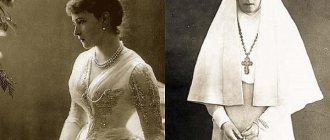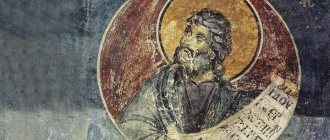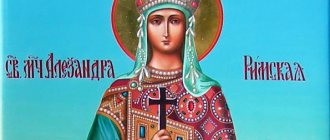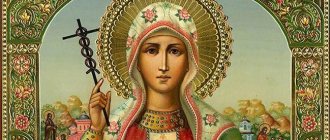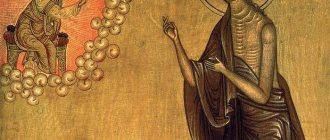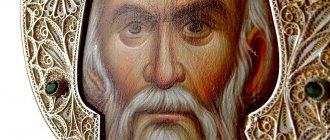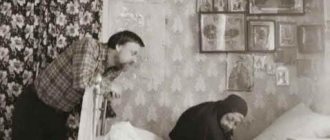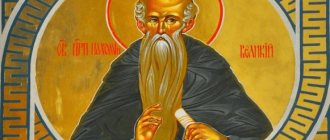Holy Love
Holy Love is an early Christian martyr of the 2nd century, who suffered for the faith along with her mother Sophia and sisters Vera and Nadezhda. The sisters' names are Old Church Slavonic translations of the Greek words Pistis, Elpis and Agape. That's what the girls were called. Sophia means “wisdom.” However, the mother's name was not translated in Russian tradition. Sofia was a deeply religious widow. She named her daughters after the three main Christian virtues and raised the girls in an ardent love for God. The pious family lived in Rome during the reign of the pagan emperor Hadrian.
Orthodox icon of the martyrs Faith, Hope, Love and their mother Sophia
The emperor learned that Sophia and her daughters were Christians, and he wanted to see them in his palace. The followers of Christ at that time were subjected to severe persecution, so the mother and her children understood what awaited them. But they also remembered the Savior’s commandment not to be afraid
“killing the body, but not being able to kill the soul” (Matthew 10:28).
With prayer and humility, the Christian women entrusted their fate to God and came to Adrian.
The pious family gave the ruler due honors. But at the same time, the girls and mother fearlessly reaffirmed their faith in Christ. Adrian was surprised at the courage of Sofia and her daughters. He settled them in the house of a pagan mentor, who was ordered to convince Christian women to renounce their faith. However, this did not bring any results. At a new meeting with the emperor, Sofia and the girls firmly refused to sacrifice to the pagan gods.
Life of Saint Lyubov of Ryazan
Blessed Lyubov of Ryazan was from the bourgeois class. Her parents, Sukhanovsky (Sukhanov) Semyon and Maria lived in the city of Pronsk, Ryazan province. Lyuba was born in 1852, on August 28 (old style). In addition to Lyuba, the family had three children: two older brothers and a younger sister.
The family lived a difficult life. One boy knew how to do it as a child. Since childhood, Lyuba had one leg paralyzed and general weakness in her body. Until the age of 15, the girl did not get out of bed. Loving parents taught her to read and write, introduced her to reading spiritual books and prayers.
The home icon in the Sukhanov family was the image of St. Nicholas the Wonderworker. Lyubov Ryazanskaya fell in love with praying to this saint from her childhood. The Sukhanov family moved from Pronsk to Ryazan, where Semyon Ivanovich soon died. The mother and the girls settled in a small, squalid house, barely making ends meet.
One day, returning home, Maria Ivanovna saw her eldest daughter standing on her own two feet without anyone else's help. To her mother’s joyful question, Lyuba replied that Saint Nicholas the Wonderworker appeared to her and ordered her to stand up and go play the fool.
Lyubov’s words about asceticism upset her mother. She turned for advice to Father John, her daughter’s spiritual mentor, archpriest of the Church of the Entrance to Jerusalem. The priest, after listening to the woman, advised not to interfere with the manifestation of God's will.
Lyubov Ryazanskaya set a test for herself by becoming a recluse. For three years she stood in the wall, not communicating with anyone. At the age of 21, a young girl came out into the world, becoming a holy fool for Christ's sake. She often left home and lived with the nuns of the Kazan Monastery. Love spent a lot of time in prayer, the rest of the time she walked around the city.
The people of Ryazan fell in love with the blessed one for her meek disposition and the gift of foresight, which the Lord awarded her. She was always friendly and did not take offense at her persecutors. Many townspeople were glad to see an ascetic in their house in a flowery dress, with a pink or blue scarf on her head. Lyubov Ryazanskaya predicted the future if she was asked to do so or without any request.
She gave her prophecies in encrypted form, cutting figures out of paper. It was not immediately possible to guess the true meaning of the prophecy, but over time it became clear what the blessed one wanted to say. For example, a wreath of flowers - for marriage, a horse - for a long journey.
All of Lyubov's predictions turned out to be correct. In January 1917, the saint rushed around the city, exclaiming that the walls of Jericho would fall (referring to the oldest city on earth in Palestine, the walls of which fell by the will of God). When the Kazan Convent closed, the nuns cried and were very worried about what would happen to them now in a world they did not know.
The blessed one carved out her own figure of a herald for each nun. As it turned out, everything turned out as the saint foresaw. When asked who would get the house after her death, the blessed one answered - the soldiers. In fact, over time, a military warehouse was built on the site where the Sukhanovs’ house stood.
Not all Ryazan residents believed in the holy fool’s predictions. Her younger sister was skeptical about Lyubov’s behavior. She believed in the holiness of her elder sister after her death, seeing how many people sincerely grieved over the death of Lyubov of Ryazan.
It was revealed to the saint when her soul would leave her body. She asked to be buried in a coffin lined with pink material (it was her favorite color). In 1921, the blessed saint died. It was a time of famine when everything was rationed. But the blessed one’s will was fulfilled: her coffin was lined with pink gauze.
A cross was placed on the grave. Admirers of the blessed one came to her to pray and ask for help from the saint. Believers received a lot of healing and help from Lyubushka Ryazanskaya. But over time, people began to forget about her, the monument collapsed, and the grave fell into disrepair.
But miracles happened that revived the memory of the holy fool. She appeared to one military man in a dream and advised him to install a fence and a monument on his grave. The man had health problems, conflicts at work and in the family. He fulfilled the command of Lyubov Ryazanskaya, and everything in his life changed for the better. From that time on, the grateful believer began to serve an annual requiem mass at the saint’s grave. Another Orthodox woman was helped to heal by oil consecrated on the relics of the blessed one and prayers.
The feat of Sofia and her daughters
Adrian tried to seduce Christian women with wealth and then with threats, but they remained steadfast. Then the ruler ordered the girls to be brutally tortured, hoping to break their mother. Faith, Hope and Love were subjected to terrible torture one after another. However, God's grace protected the young Christians: neither fire nor boiling tar harmed them. Sophia, all this time, encouraged her daughters and instructed them to be faithful to Christ to the end.
The emperor was not convinced by the miracles, and he executed the girls, ordering their heads to be cut off. Lyubov, the younger sister, was only 9 years old. Nadezhda is 10 years old, and Vera is 12. Sofia was left alive, doomed to mental suffering from separation from her murdered daughters. The mother buried the martyrs in the outskirts of the city and died at their grave.
“So the wise Sophia ended her life wisely, bringing her three virtuous daughters Faith, Hope and Love as a Gift to the Holy Trinity” (St. Demetrius of Rostov, “Lives of the Saints”).
The feat that Saint Lyubov and her relatives accomplished became clear evidence of the triumph of faith and spirit over brutal physical force. The execution of the young women devoted to God shocked the pagans and inspired Christians. Children began to be named after martyrs, including in Rus' with the advent of Christianity. These names remain popular to this day. The holy remains of the four martyrs have been kept in Strasbourg (France), in the Escho Abbey since 777. Memorial Day of Saint Sophia and her daughters Vera, Nadezhda and Lyubov is September 30.
Veneration in Orthodoxy
The ascetic chose as her destiny to serve the Lord through compassion and helping people with a kind word, a friendly smile, and the gift of foresight. Since 1987, Lyubov Sukhanova has been revered as a locally revered saint and beatified and included in the Council of Ryazan Saints. The days of remembrance fall on the day of death (February 21) and the celebration in honor of the Ryazan saints (June 23).
In 1992, a chapel was erected at the grave. After 6 years, the burial was opened, some of the relics were transferred to the Church of St. Nicholas the Wonderworker (city of Ryazan), some remained in the chapel.
Holy love in Christianity
The names of the holy martyrs are deeply symbolic. Faith, hope and love are mentioned by the Apostle Paul as the main Christian virtues (1 Cor. 13:13). Wisdom (Sophia) protects them. Theologian Yuri Ruban points out that together they
“they elevate man from the captivity of natural necessity to the kingdom of moral and intellectual freedom and lift the veil of eternity for him.”
These three virtues are interconnected and without each other they cannot be fully complete. Hope is the good fruit of faith, which revives and strengthens it. Archpriest Alexander Nemchinov notes that
“It is in hope that faith is tested and forms an indissoluble whole, which is revealed in love.”
The Apostle Paul exalts love above other spiritual gifts because it is eternal and divine. In Eternal Life there will be no need for faith, since for Christians it will turn into a vision (2 Cor. 5:7). And there will be no need for hope either, since it will become a possession (Rom. 8:24). Love “never ceases”; it will continue into Eternity, since it belongs to the very essence of God. “Whoever does not love has not known God, because God is love,” writes the Apostle John the Theologian in his first Epistle.
Love is the ultimate goal for Christians, the content and meaning of all life, including the future. Faith and hope are only means to achieve this goal. The Lord showed us an invaluable example of love with his sacrifice on the cross for the sake of people. AND
“If God so loved us, then we should love one another... if we love one another, then God also abides in us, and His love is perfect in us” (1 John 4:8-12).
Thus, love for our neighbor makes us involved in Divine love. Growing in this virtue, a Christian becomes like the Lord.
History of the icon “Faith, Hope, Love”
In the Roman Empire at the beginning of the 2nd century AD, in the domain of Emperor Hadrian, there lived a noble woman who bore a name meaning “wise” - Sophia. When her daughters were born, she gave the names of the great Christian virtues: Faith, Hope and Love. That is why, when we now consider what the icon “Faith, Hope, Love and their mother Sophia” means , not only the direct meaning is indicated, but also the deep meaning, which points to the figures of the image, which also embody virtues in the flesh.
Sofia was an extremely religious person and wanted to teach her children to believe in divine help and raise them from early childhood not to become attached to material needs. In addition, Sofia was widowed in a short period after the birth of the girls and therefore completely devoted herself to Christianity and raised her daughters in this vector. The girls became righteous from a young age and prayed and fasted a lot and studied the scriptures. Rumors about the Christian family quickly spread throughout Rome, and the emperor, having learned about this, ordered them to be brought to him to see in person.
Standing before the emperor, without lowering their eyes, they told Adrian about God, and in fits of anger, he ordered to extort their loyalty to Christ from the girls - by force. And the first person the executioners tried to punish with fire torture was the elder sister Vera, but prayers helped her overcome this element. And the order came to cut off the girl’s head; without fear, she brought her head up.
The eldest's feat gave strength to those remaining in her family to fight. The sisters were subjected to similar torment, but did not reject their faith until the very end. Sofia suffered severe mental pain, despite all this, she experienced much more. After the girls' remains were buried on the hill, Sophia prayed there for three days and then died peacefully.
How to Pray for Love and Marriage
Which saint should I ask for love? You can pray for love to any saint, because they all help convey our prayers to God. It is the Lord who fulfills requests. In Orthodoxy there are no special prayer texts and icons that guarantee love and marriage. This attitude towards shrines is superstitious. The benefit comes not from the mechanical recitation of a prayer, not from the presence of a certain icon in the home iconostasis, but from our heartfelt participation, faith and trust in God’s help. Also, the person praying needs to understand that a loving God knows better than man how to help him. Therefore, genuine prayer must be imbued with humble admiration for the will of the Almighty.
Which icon should I pray to to get married? As has already been said, it does not matter in front of which icon one offers prayers to God. However, in Orthodoxy there is a pious custom of praying for the gift of love in front of the icon of the Mother of God “The Unfading Flower.” On it, the Mother of God holds the Divine Infant with one hand and a white flower with the other. It symbolizes the purity, beauty of virginity and sinlessness of the Virgin Mary. Therefore, it is believed that the “Fadeless Flower” is the most suitable icon for marriage.
According to the most common version, the image was first painted in the 17th century on Mount Athos. The inspiration for its creation was the texts of the Mother of God akathists. There are a large number of different versions of this icon. The day of veneration of the image “Unfading Color” is April 16.
Where to pray to the icon “Faith, Hope, Love and their mother Sophia”
Relatively recently, the relics of the saints were in the Danilovsky Monastery, the icon “Faith, Hope, Love” was also brought there for veneration. Therefore, believers could turn to these shrines in order to receive help.
In addition, this image, which believers can pray to, is available in many churches; it depicts Sophia hugging her young daughters.
The day of veneration of the icon is September 30.
Prayer to the martyrs Vera, Nadezhda, Lyubov and their mother Sophia
Troparion, tone 4
The Church of the firstborn triumphs,/ and the mother rejoicing over her children will rejoice,/ even as the wisdom of the same name/ with the triple theological virtue of equal generations./ You I and the wise virgins behold the ignorant Bridegroom God’s Word,/ with her we also rejoice spiritually in their memory, saying:/ Trinity champions,/Faith, Love and Hope,//affirm us in faith, love and hope.
Kontakion, tone 1
Honest Sophia of the most sacred branches, / Faith and Hope and Love, appearing, / wisdom enshrouded by Hellenic grace, / both the sufferer and the victorious, appearing, / Vlada, an incorruptible crown from all The kin of Christ got stuck.
How does the holy image help?
Prayer in front of this holy icon helps to build a strong, reliable family and find family happiness. Also in front of the shrine they ask:
- about the birth of children,
- about children's health,
- about healing from women's diseases,
- about healing from joint pain.
If you sincerely read the prayer in front of the icon of Faith, Hope, Love and their mother Sophia, then it will help protect your loved ones from temptations. Prayer helps restore peace, joy and happiness to the family. The main thing is to read it sincerely and with soul. The date of commemoration of the saints is September 30. It is also the day of the angel of girls with the same names as saints.
Prayer to the icon of Faith Hope Love is read in these words:
“Oh holy martyrs Vero, Nadezhda and Lyuba, and wise mother Sophia! We come to you now with fervent prayer. Pray to the Lord, that in sorrows and misfortunes He may cover us with His indescribable grace, His servant (names), and preserve Him, and may He be worthy to see His glory, like the unsetting sun. Help us in our humble prayers, may the Lord God forgive our sins and iniquities, and may He have mercy on us sinners, and may Christ God vouchsafe us His bounties, to Him we send up glory, with His Beginning Father, and His Most Holy and Good and Life-giving Spirit, now and ever and unto ages of ages.”
May the Lord protect you!
The best article for you, go to: The Icon of the Mother of God “The Leaping of the Baby” in what it helps, meaning
Watch also the video about the miraculous icon of the holy martyrs:
